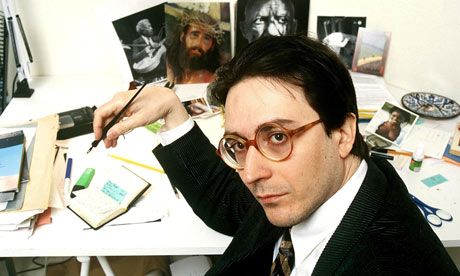
Marc-Édouard Nabe has always relished playing with fire, but never more so than when he burned what would have been the fifth volume of his journal. His main motivation was to avoid being trapped in a Shandyesque race with time, ending up pigeonholed as a diarist. Nevertheless, he went on to describe this event in Alain Zannini, his 2002 novel, which was so blatantly autobiographical that it even bore his real name as its title (Nabe, short for "nabot" – midget – is a nom de plume). The implication was clear: having lived his life in order to narrate it, Zannini had gradually become Nabe's creation. What, then, would happen if the writer were to stop writing?
This ontological question is raised in L'Homme qui Arrêta d'Écrire (The Man who Stopped Writing, 2010), which begins with the author-narrator's paradoxical assertion – given the length of the tome, let alone its very existence – that he has forsaken literature after being dropped by his publisher. "A publisher paying me to write books nobody reads," he deadpans, "I thought this would go on for ever."
For the best part of two decades, the real-life Nabe had received a monthly wage from Les Éditions du Rocher. When this stipend was suddenly withdrawn, following a takeover in 2005, the author decided to take legal action. Throughout the lengthy lawsuit, he expressed himself by means of posters, which his hardcore supporters pasted all over the walls of France's major cities. He also maintained the fiction that his authorial days were over, so as to remain in character while writing his novel about writing no more.
The appearance of L'Homme qui Arrêta d'Écrire thus came as quite a surprise, not least because Nabe chose to go down the self-publishing, or rather "anti-publishing," route. The minimalist jet-black cover has a whiff of piracy about it: no barcode, no ISBN, no publisher's name or logo; the spine remains bare. On the front, the author's name is reduced to "Nabe" as if it had become a brand, and on the back you only find a number, indicating that it is the writer's 28th published work (and seventh novel). The book is exclusively available through an official website and a handful of highly unlikely retailers (a butcher's, a florist's, a hairdresser's and two restaurants at the last count). By cutting out the middleman, Nabe claims to be able to make 70% profit, instead of the usual 10%, on each copy sold. The initial print run – funded by the sale of his paintings (Nabe is also an artist and jazz guitarist) – sold out within a month. The novel was even shortlisted for the prestigious Renaudot prize, a first for a self-published volume in France.
This declaration of war on the publishing industry is in keeping with Nabe's image as a latter-day écrivain maudit. Initially accused of being a neo-fascist (partly because of his predilection for Céline and Lucien Rebatet), Nabe is now frequently depicted as a pro-Palestinian leftist. His first television appearance, in 1985, proved so incendiary that he was beaten up by a leading anti-racist campaigner. Looking every inch the provocative young fogey, complete with centre parting, bow tie and retro spectacles, he declared that every day he shoots up with a Montblanc pen full of "utter hatred of humanity". A great admirer of Jacques Mesrine, Nabe famously befriended the flamboyant bankrobber Albert Spaggiari as well as Venezuelan terrorist Carlos the Jackal. Following 9/11, he produced a pamphlet entitled A Glimmer of Hope and, since then, has repeatedly argued that Osama bin Laden is only acting in self-defence. In 2003, he even travelled to Baghdad, where he protested against the invasion of Iraq in typically Gallic fashion: by writing a novel. These antics may have earned him a large cult following, but Mazarine Pingeot summed up the views of many when she declared that Nabe was "unfortunately" a great writer.
Great or not, Marc-Édouard Nabe is an important figure on the French literary scene. Along with Michel Houellebecq, he is one of the only authors to have chronicled the strange death of France's joie de vivre. With its rogues' gallery of modern Tartuffes, L'Homme qui Arrêta d'Écrire is a roman à clef that lampoons every aspect of contemporary Parisian life, particularly its incestuous literary milieu peopled with floppy-haired Beigbeder clones. This, alas, is one of the reasons why the novel probably won't be translated: most references would be lost on a foreign readership. The names of all the famous people who appear have been slightly doctored (Depardieu, for instance, becomes Depardieux), signalling that they have stepped through the looking-glass of fiction. As one of the characters remarks, a mere typo can plunge you into another universe.
This grey area between fact and fiction has been the stomping ground of many a French author since the late 70s, when Serge Doubrovsky coined the word "autofiction". In recent months alone, both Régis Jauffret and Christine Angot have been sued for fictionalising real-life events and individuals. Zannini/Nabe, whose entire oeuvre is haunted by the figure of the double, once said that his novel Alain Zannini – in which Zannini and Nabe meet – was told in the "double person singular". Sometimes, however, I really is another, rather than just the other half of a divided self.
Although no oil painting, Houellebecq is Dorian Gray to Nabe's picture – the acceptable face of controversy. Or at least this is Nabe's spin on events. In the early 90s, both men lived at the same address (103 Rue de la Convention in the 15th arrondissement) facing each other, like bookends, across a cobbled courtyard. Both belong to the same generation, come from similar lower middle-class backgrounds, had domineering Corsican mothers they rebelled against and established their reputations by courting controversy. Nabe was the senior partner in this relationship, up until the success of Atomised in 1998.

